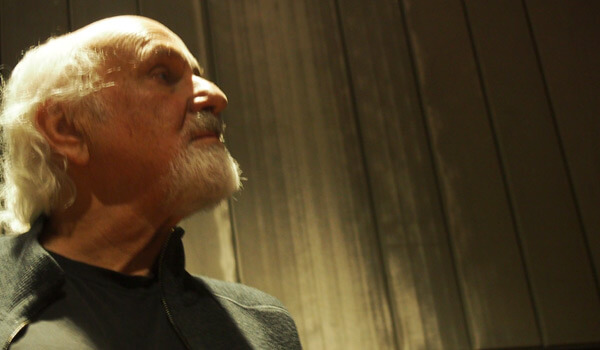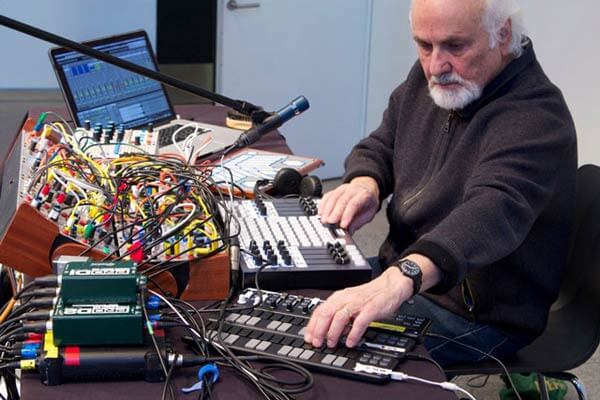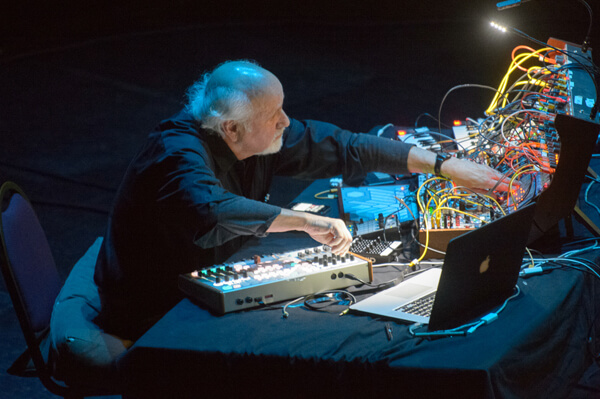 Morton Subotnick, a true pioneer of electronic music, celebrated his 80th birthday this year. Yet only his halo of white hair, snowy goatee, and a slight limp gave any sense he was a day over 65 when he mounted the stage to perform From Silver Apples of the Moon to A Sky of Cloudless Sulphur IV: LUCY at Cleveland’s Museum of Contemporary Art (MOCA) on Thursday, November 14, 2013. No doubt staying in the avant garde of electronics in music has kept him surrounded by younger people. Perhaps he has continuously re-absorbed youth by osmosis along the way. His performance was both historical, in that it contained many recorded samples of all his previous work since the 1960s, and of-the-moment, as he spontaneously mixed his samples and vocalizations into a sorcerer’s brew via live manipulation and processing.
Morton Subotnick, a true pioneer of electronic music, celebrated his 80th birthday this year. Yet only his halo of white hair, snowy goatee, and a slight limp gave any sense he was a day over 65 when he mounted the stage to perform From Silver Apples of the Moon to A Sky of Cloudless Sulphur IV: LUCY at Cleveland’s Museum of Contemporary Art (MOCA) on Thursday, November 14, 2013. No doubt staying in the avant garde of electronics in music has kept him surrounded by younger people. Perhaps he has continuously re-absorbed youth by osmosis along the way. His performance was both historical, in that it contained many recorded samples of all his previous work since the 1960s, and of-the-moment, as he spontaneously mixed his samples and vocalizations into a sorcerer’s brew via live manipulation and processing.

Morton Subotnick (photo credit: Larry Dunn)
Looking like a learned shaman, Subotnick seated himself at an elaborate workstation consisting of a Buchla Music Easel (an updated version of the first-ever music synthesizer, which he helped develop in the 60s), microphone, multi-part touchpad interface, laptop, and more. It was all routed through a quadrophonic sound system from the TIMARA (Technology in Music and Related Arts) department of Oberlin Conservatory, which co-sponsored Subotnick’s visit, including a lecture at the conservatory the following day. Four large monitors surrounded the audience, one in each corner of the open ground-floor gallery. After pausing a moment to ready himself, Subotnick launched into a series of wordless vocalizations that were transformed into pure sound and shifted around the room like they were powered by a cyclotron. This set the tone for his hour-long program full of shifting textures, timbres, density, and dynamics. Although there were no definitive stops, it was composed of three distinct sections that seemed to embody new ways of hearing the energy of the universe.
The opening section evoked the scene of some primordial swamp, full of gurgling water, croaking frogs, and buzzing insects, intersecting with wild winds and ghostly beings. Subotnick gradually built the complexity of the texture, adding waves of samples to the mix, creating more layers of sound. As the tempo and dynamics increased, it became difficult to discern the individual elements. One became immersed in its totality, mesmerized by the engulfing sound, only to be jolted awake by a loud blast and then returned to long steady tones eventually fading to near silence.

Morton Subotnick (photo credit: timara.oberlin.edu)
Subotnick initiated a new construction in section two as a thin gauzy fabric was punctuated by a persistent low-frequency 1-2 thump. He transported this beat throughout the gallery as this soundscape unfolded. Over this beat were crazy, wild combinations of shrill sounds morphing from disorganized chaos into more parallel structures. It was like being transported into a hidden dimension where we could hear energy darting around the room as light rays and thermal currents caused gas molecules to collide. Subotnick added more materials to the mix, thickening the texture and increasing the intensity, sounding as if we were caught up in the tail of a comet flying high above the earth. The texture gradually scaled back to only two or three lines, with Subotnick’s humming vocalizations bringing a momentarily subdued calm. He then rebuilt the complex texture at a rapid pace, increasing the volume to a crescendo with that thumping bass vibrating the entire room. With that climax exhausted, the sounds slowly dissolved and faded.
The final section inhabited a more human sphere, beginning with the haunting sounds of a disembodied female voice chanting quietly. Subotnick added processed live vocalizing and a steady percussive tapping, soon joined by the orbiting sound of a ball bearing rolling around the outer rim of a hubcap. The human vocal sounds continued to dominate and morph into moans, sighs, and heavy breath sounds as if trying to communicate with the universe on a new channel. It was fascinating to observe how the specific gestures Subotnick made on his touchpad and with his mouth at the microphone gave shape to the sounds that emerged. The texture soon thickened and became more complex as intricate plucking and striking sounds joined the mix. It sounded like some ancient sonic communication system using muted marimba, hammered strings, and kalimba. The textures and dynamics built to another crescendo of enormous beauty, then suddenly dissipated to silence.
After a sustained standing ovation, Subotnick returned to the stage for a short improvised encore with a free-jazz feel. He opened with a rapid riff of processed vocalization that reminded us that he had an early career as a virtuoso clarinetist. His voice receded and electronic samples came to the fore at nearly manic speed, dominated by heavy low frequency thumps. It seemed at once both chaotic and precise, and came to an abrupt halt.

Morton Subotnick (photo credit: Adam Kissick for NPR)
Following the performance, Subotnick described his workstation set-up to us in a little more detail. His Buchla Music Easel is equipped with only two oscillators, but he multiplies their effects using Ableton software on the laptop. Two ten-button keypads on his left, enable him to select which samples go through which software multiplier. With the multi-part touchpad on his right he manipulates the shape, tempo, and volume of the samples he selects to play. In the program notes, he stated: “For each season of performances I create a new hybrid Ableton-Buchla ‘instrument’ loaded with prepared samples from all my previous works and performances and new patches that will allow me to modify the samples while performing brand new sound gestures created especially for the new season.” He plays from a score, displayed on the laptop, which defines the order of samples to be played but allows ample space for spontaneity in how he manipulates those samples.























